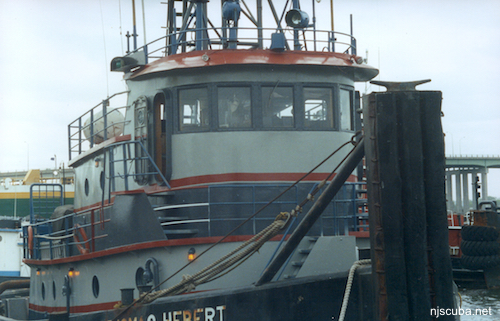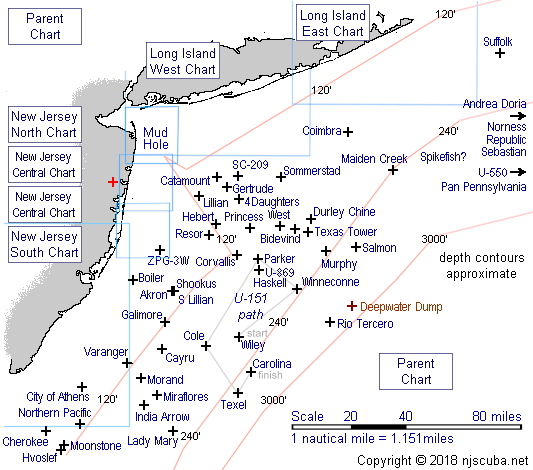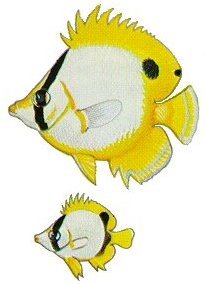Thomas Hebert (2/2)
A little Geometry and Physics, and some Common Sense

When a small force is applied perpendicular to the center of a non-elastic line, it generates a much larger force at the ends. For the geometry of a sub snagging the center of a 1200 foot tow cable, the force generated on the ends might be on the order of 100 times the force applied by the sub on the cable.
Both the submarine and the barge are much larger than the tugboat, with much greater mass and inertia. A Los Angeles class submarine is almost 7000 tons submerged, traveling at up to 20+ knots. The barge was 8,500 tons net, probably around 10,000 tons total. The Thomas Hebert was about 100 tons, not even a tenth of the size of the other two objects.
The force generated on the cable by the sub would not be insubstantial. The resulting reactions of the three points - sub, barge, and tug - would be inversely proportional to their masses. The sub would hardly slow down, the barge would hardly move, and the tugboat would go flying like a yo-yo.
As the heavy sub plows forward into the cable, it would likely suffer dents and abrasions, and damage to soft parts, but little more. Submarines are built extremely strongly, for example, the sail can smash through 2 meters of arctic ice to the surface. Nothing would happen to the barge. The tug, however, would be violently jerked backward into her own wake, flooding the back deck and any spaces below that were open. Engines and electrical service would go out, and it would quickly sink.
This is exactly what is described by the survivors of the Thomas Hebert, and exactly the scenario of the sinking of the Barcona. The Barcona was jerked so violently that the water smashed the back windows. There is no evidence to support the other theories, such as 'self-tripping', but there is evidence against them, such as the rudders being found almost straight. The Coast Guard's official conclusion sounds like utter hogwash to me. Draw your own conclusions.
There is one more note I would add, in favor of the Navy. If it was a submarine, I think it is much more likely to have been a foreign one that was sneaking around to see what they could get away with, rather than a US Navy boat that would have no reason to be operating like this in this region. It would have been quite a coup for a Russian sub to get within 50 miles of New York, and quite an embarrassment for the U.S. That Captain would be the toast of the fleet. If it was a Russian sub, they would have had every reason to sneak away after a fatal accident, that's what they were going to do anyway. Note that in the Barcona incident, the US Navy sub stopped and rendered assistance; they did not try to sneak off. I don't think any American Navy Captain would do differently under the same circumstances.
Some Russian submarines are known to have outer hulls of high-chromium stainless steel. This may well have been some special mission that went very wrong. Our Navy might not want to admit that a foreign sub got past them, almost to New York undetected. Or maybe it didn't get past them, and they don't want anyone to know how well they can track intruders. Or maybe my theory is completely wrong and there never was a foreign sub. There are any number of possible reasons for the Navy and Coast Guard not to admit anything about this incident ( or even lie about it, ) not the least of which is that they had nothing to do with it. The real answer to what happened to the Thomas Hebert may well be in Moscow.
Sub Sinks Tugboat
1 Man Lost
Snags Towline, Pulls Boat Under
June 15, 1989 | By SCOTT HARRIS and JAMES RAINEY Los Angeles Times
LONG BEACH, CALIF. — A nuclear-powered Navy submarine involved in the making of the film "The Hunt for Red October" accidentally sank a tugboat early Wednesday when it snagged the tug's tow cable and yanked the boat underwater about 10 miles southwest of Long Beach.
One crewman of the tugboat Barcona was missing and presumed dead late Wednesday despite a daylong search that involved four Coast Guard vessels, two helicopters, and the Houston, the submarine involved in the accident.
Two other Barcona crewmen jumped into the fog-shrouded sea and managed to swim to an empty barge their tug had been towing. Later, the two survivors told investigators of moments of terror - of how their 97-ton, 73-foot tug was jolted backward and sunk by an unseen force.

The Houston, a fast-attack submarine, launched in 1981 at Newport News Shipbuilding, is based in San Diego. It was in the Long Beach area to assist in the filming of "The Hunt for Red October," a tale of a Soviet submarine commander's defection to the United States, said Lt. Sonja Hedly, a spokeswoman for the Naval Submarine Base San Diego. "But this incident had absolutely nothing to do with Hollywood or with the filming," Hedley emphasized.
Shooting had been planned for later in the day. But there were no actors or film crew present when the accident occurred.
Hedley said the Houston was submerged when it caught the tow cable linking the Barcona to two empty barges at about 4:45 a.m. Navy officials refused to disclose the submarine's depth, speed, whether it was in descent when the accident occured, or whether its sensors should have detected the Barcona's 1,000-foot steel cable.
Hedley said the accident would be investigated by the Coast Guard and the Navy and that no further details would be released until the investigation was completed.
The sinking of the Barcona was described in an interview by Cmdr. Donald Parsons, chief of investigations for the Coast Guard's Los Angeles-Long Beach group, and in a press conference by Ralph Larison, president of Connolly-Pacific Co., a marine construction company that owns the tugboat and employs the crew.
Both men had talked with the two survivors, Barcona captain Mike Link and deckhand Daniel Rodriguez. The third crewman, Bryan Ballanger, 32, married and the father of two children, was last seen going below deck to check on the Barcona's engines moments before the boat went under in 2,500-foot-deep waters.
Ballanger was piloting the vessel through a thick fog at about six knots, while Link and Rodriguez slept below deck when the accident occurred. That was standard practice, Larison said. Ballanger was a licensed tugboat pilot.
"They were jerked backward with such a force that water came over the stern of the boat and the rear windows were knocked out," Larison said. Crew members estimated they were being towed backward at about 10 knots.
Link went above deck to talk with Ballanger, Parsons said, but neither could understand what was happening to their boat. The pilot then decided to check the engine room.
"The tug was pulled down and sank," Parsons said. "It happened in less than one minute."
As the tug started sinking quickly, Rodriquez jumped overboard, and Link followed moments later.
In the movie based on Tom Clancy's best-selling suspense novel, "The Hunt for Red October," the USS Houston portrays an American submarine, the USS Dallas.
Navy officials occasionally permit movie and television producers to make use of Navy vessels, but rarely allow access to nuclear-powered submarines. However, Navy officials said they hoped "Red October," starring Sean Connery and Scott Glenn, would provide a boost in enlistment for the submarines and surface ships just as the movie "Top Gun" brought a flood of enlistments in the Navy aviation program. A Navy spokesman said Paramount Studios is charged $400 an hour for the period in which the Houston is used.
http://articles.dailypress.com/1989-06-15/news/8906150126_1_barcona-tugboat-tow-cable
A Tug's Fatal Tow
No Sub To Blame In 1993 Accident, Coast Guard Says
December 13, 1994 | By WILLIAM H. MCMICHAEL Daily Press
The tugboat Thomas Hebert was probably dragged under and sunk by the coal barge it was towing, not by a Navy submarine, according to a Coast Guard report on the 1993 accident that killed two Hampton Roads watermen.
But after 20 months of questions, the report admits that "the exact nature of that event may never be known."
The tug went down in March 1993 in frigid waters off New Jersey as it was towing a load of coal from Newport News to Maine. Five men died and two were rescued by a Hampton-based fishing boat.
The Coast Guard concludes that the Thomas Hebert was pulled under by its own cable after a faulty steering mechanism caused it to turn and pass the coal barge going in the other direction. Relatives of some of the men lost in the accident suspect that a sub caught the cable and caused the tug to sink.
"I think it's all bull," said Vincent "Chippy" Blanks, father of a Gloucester man who died in the accident. "We're still going after the Navy. We're going to try to prove that a submarine is what caused it."
The five victims were Vincent Blanks of Gloucester; James E. Westmoreland of Norfolk, Charles Landers of Elizabeth City, N.C.; George W. Coram of Theodore, Ala.; and Mabuary G. Hatch of Del Rio, Tenn.
A copy of the Coast Guard report was obtained by the Daily Press through the Freedom of Information Act.
What the Coast Guard thinks happened is this:
At around 3 a.m. on March 7, 1993, the tug was set on autopilot, pulling the 340-foot barge northward through the Atlantic. A faulty solenoid caused one of the tug's two rudders to turn the boat to the left. The barge, which with its cargo weighed more than 12,000 tons, continued forward as the tug steered off course.
When the tug was far enough from the barge to take up all the slack in the 1,200-foot, 2-inch-thick cable, the stern of the tug was pulled down violently. Water rushed through an open engine room door, and the tug was pulled under.
Survivors said only two minutes elapsed from the time the tug first listed until it sank.
The Thomas Hebert, said the report, had a history of solenoid failures. According to the two survivors - William E. Landers of Elizabeth City, N.C., the tug's captain and Charles Landers' brother, and Brett S. Cooper of Ruskin, Fla., both of whom were rescued by the Hampton-based fishing vessel Miss Mandy - a similar failure had taken place on the tug's previous voyage.
But relatives and others interviewed last year suspected that a submarine was to blame. A comparable incident occurred on June 14, 1989, off of Long Beach, Calif., when the USS Houston snagged a 1,000-foot tow cable and sank the tug Barcona, killing the pilot.
In response to a Coast Guard query about the Thomas Hebert, the Atlantic Fleet responded that although its submarines did conduct operations in that area, none had been within 62 miles of the tug when it went down. The closest - the attack sub USS Newport News - had been operating south of the Chesapeake Bay, the Navy said. A spokesman for Submarine Force Atlantic also said he was unaware of any foreign submarines in that vicinity.
Within days of the Thomas Hebert sinking, a woman called the Daily Press claiming that a disabled or crippled sub had pulled into Norfolk Naval Shipyard.
The Navy said the Newport News entered Newport News Shipbuilding for scheduled maintenance after the Thomas Hebert went down. But, wrote the fleet's inspector general, Kevin F. Delaney, "there was no damage to the sail and electronics, and therefore, no investigation was conducted."
The Coast Guard report also discounted the submarine hypothesis on two other counts. First, the accident took place in roughly 150 feet of water, considered too shallow for normal submarine operations. Second, while Navy submarines are painted black, the damaged portion of the tow cable contained the residue of gray paint, matching the color of the barge.
http://articles.dailypress.com/1994-12-13/news/9412130070_1_coal-barge-coast-guard-tug-s-captain
Mystery Surrounds Tugboat Accident
One Theory Places Blame On Navy Sub
March 25, 1993 | By WILLIAM H. MCMICHAEL Daily Press
Why a powerful, Hampton Roads-based tugboat suddenly sank in frigid waters off the New Jersey coast in the early morning of March 7 continues to baffle observers.
Five of the seven crewmen aboard died when the 110-foot Thomas Hebert listed at a sharp angle and plunged to the bottom in 20 seconds. The tug was pulling a coal-bearing barge on a cable 1,200 feet long and 2 inches thick and was headed to Portland, Maine, from Norfolk.
FOR THE RECORD - Published correction ran Friday, March 26, 1993. An article in Wednesday's Local section about a tugboat accident off the New Jersey coast incorrectly identified Charles L. Landers as the son of William Landers. They are brothers.
Still officially listed as missing by the 1st District office of the Coast Guard are Vincent Blanks of Gloucester, James Westmoreland of Norfolk, Charles Landers of Elizabeth City, N.C., George Coram of Theodore, Ala., and Mabuary G. Hatch of Del Rio, Tenn. Surviving were Landers' father, tug skipper William Landers, and Brett Cooper of Ruskin, Fla.
In addition, a diver for the crew recovering the bodies died Monday night when he became disconnected from his air supply.
The accident is shrouded with mystery. Initial reports from divers say the hull is undamaged. The seas were calm, winds were light, and visibility was more than 11 miles.
According to Coast Guard Cmdr. Cordell Viehweg of the Marine Inspection Office in New York, there are several theories. One is that a Navy submarine hit the towing cable.
"We have made inquiries to the Department of the Navy to see if there's any validity to that theory. As of this time, the Navy has denied any activity in the area," Viehweg said.
Viehweg added three more possibilities. "There's a lot of cable out there," he said. "It's possible the cable snagged on the bottom." At the time, the Thomas Hebert was in water 150 feet deep.
"It's possible the barge passed the tug," he added. "Or a surface vessel could have cut between the barge and the boat."
Those scenarios were discounted by Carl Jacoby, a retired tug skipper who worked 14 years for S.C. Loveland Co., the firm that leased the Thomas Hebert and owned the barge in tow.
"It would have taken one hell of a surface vessel to jerk a tug off its `feet' like that," said Jacoby, noting that the Hebert and its fuel likely weighed about 112 tons. He also doubted the possibility of the tug being passed. "In my 14 years, I've never seen a Loveland barge pass a boat."
Jacoby admitted that it's possible for the long cable to touch bottom if a tug loses power but that would not have sunk it. And Viehweg said that even if the cable dragged the bottom, it's not likely that it would have caught on anything. "We know of no major obstruction on the bottom in the area at this time," he said.
Divers have taken underwater photos of the Hebert and the cable. The Coast Guard isn't releasing details of its findings, but Loveland sources say the hull of the boat isn't damaged.
Vincent "Chippy" Blanks of Gloucester, whose son Vincent was one of the drowned crewmen, says he's heard through the mariners' grapevine that the cable appears to be frayed. "It was a brand-new cable," said Blanks. "It was put on Feb. 15."
A frayed cable would indicate that some sort of collision took place, leading most observers to conclude the culprit was a submarine despite Navy denials.
"I think a sub hit the cable," said Jacoby. "The boat took a 30-degree list instantly. You've got to have something tremendously big out there to cause that."
Loveland officials also think a sub is to blame. "That's the only theory that we can come up with," said George Greaves, a company spokesman. "There are documented cases of this happening before."
One such incident occurred June 14, 1989, off Long Beach, Calif., when the USS Houston snagged a 1,000-foot tow cable and sank the tugboat Barcona, killing the skipper.
As described by witnesses, the Houston pulled the tug backward and instantly yanked it down into the water. The description is nearly identical to that provided by the Hebert's survivors.



Questions or Inquiries?
Just want to say Hello? Sign the .